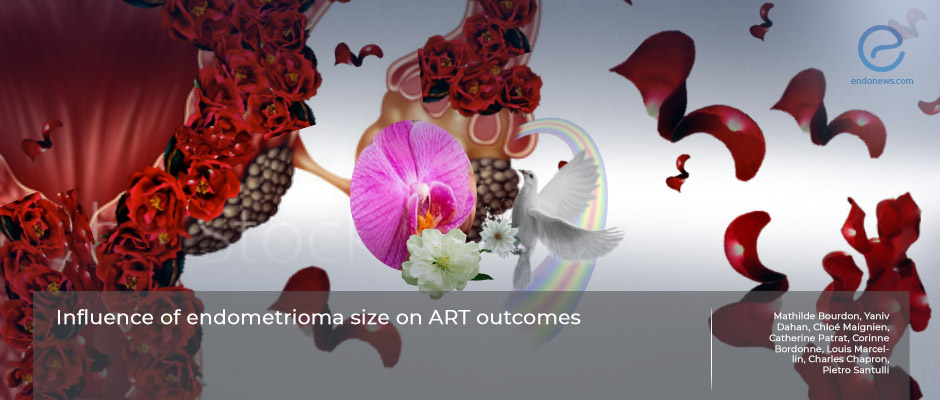Does endometrioma size have an effect on IVF/ICSI outcomes?
Nov 24, 2022
The size of the endometrioma does not affect in vitro fertilization / intracytoplasmic sperm injection results.
Key Points
Highlights:
- There may be no necessity to treat endometriomas before ovarian stimulation in order to improve IVF/ICSI success, even with large endometriomas.
Importance:
- Ovarian stimulation can be offered as a treatment modality for infertile endometriosis patients regardless of endometrioma size.
What’s done here?
- This observational retrospective study was conducted to assess the impact of endometrioma size on IVF/ICSI outcomes in women with endometriosis-associated infertility.
- Patients with unilateral/bilateral endometrioma and DIE who underwent IVF or ICSI were included.
- The largest diameter was accepted as "endometrioma size", and DIE lesions were classified into location groups (bladder, uterosacral ligaments, vagina, intestine, and ureter).
- The age, BMI, smoking habits, gravidity and parity, antral follicle count, serum FSH, AMH levels, type and duration of infertility, previous endometriosis surgery, and other infertility causes were evaluated.
- The gonadotrophin dose and type of ovarian stimulation protocol were determined based on the patient's individual characteristics.
- Endometrioma diameters were also grouped [<2 cm, 2-4 cm, 4-6 cm, 6-8 cm, ≥8 cm] and all main outcomes were compared between the groups.
- The number of oocytes retrieved per woman was accepted as the primary outcome; secondary outcomes were the cumulative clinical and ongoing pregnancy, miscarriage, cumulative live birth rates, and obstetrical/neonatal outcomes.
Key Results:
- A total of 326 endometriosis patients were included, 59 (18.1%) had a previous endometrioma surgery.
- The largest endometrioma was 3.80 ± 3.11 cm.
- There was no significant association between the number of oocytes retrieved and the mean size and the laterality of endometrioma, association with adenomyosis, and the type of DIE associated with endometrioma.
- Oocyte yield was significantly associated with age, ovarian reserve on day 3 (AFC, FSH, and AMH), tubal infertility factor, the total gonadotrophin dose, duration of the stimulation, use of a short agonist stimulation protocol, and oestradiol concentration on trigger day.
- The patient's age, smoking, serum 3rd day FSH levels, and previous endometriosis surgery significantly diminished the number of oocytes retrieved.
- Bilaterality was found to be significantly correlated with the largest endometrioma diameter.
Strengths and Limitations:
- This is the largest study assessing the association between ovarian responsiveness during IVF/ICSI cycles and endometrioma size, the inclusion of women with large endometriomas (≥8 cm) and DIE lesions is another strength.
- Retrospective design and the inclusion of patients at a referral center could be considered as a limitation as they may have more severe diseases influencing IVF/ICSI success.
Lay Summary
Assisted reproductive technologies including IVF/ICSI can be suggested as the therapeutic option in women with endometriosis-associated infertility. In literature, there is a controversy regarding the influence of endometrioma size on IVF/ICSI outcomes. The group led by Drs Chapron and Santoulli from France published an article titled “Influence of endometrioma size on ART outcomes” in the journal Reproductive BioMedicine Online.
The authors aimed to evaluate whether there is an impact of endometrioma size on IVF/ICSI outcomes in women having endometriosis-associated infertility. They included patients with endometriosis even greater than 8 cm in the largest diameter and compared all main outcomes of the study. The proportion of women with a prior history of endometriosis surgery, ovarian stimulation characteristics, oocyte yield, cumulative clinical and ongoing pregnancy, cumulative live birth and miscarriage rates, the mean number of embryo transfers, and the number of canceled cycles were comparable between the groups with different endometrioma sizes.
Only bilaterality was found to be significantly associated with endo size. On the other hand, variables significantly associated with oocyte yield were detected to be age, ovarian reserve on day 3 (AFC, FSH, and AMH), tubal infertility factor, total dose of gonadotrophin, duration of the stimulation, use of a short agonist ovarian stimulation protocol and oestradiol concentration on trigger day.
“Ovarian stimulation can be of benefit to women irrespective of the endometrioma size. Our results are reasons to propose that there is no need to treat ovarian cysts before ovarian stimulation in order to improve ovarian responsiveness, even with large endometriomas. However, larger prospective controlled studies should be performed to confirm these results,” they added.
Research Source: https://pubmed.ncbi.nlm.nih.gov/36167632/
endometriosis endometrioma deep infiltrating endometriosis infertility IVF/ICSI outcomes ovarian stimulation oocyte retrieval pregnancy rate ovarian reserve surgery

